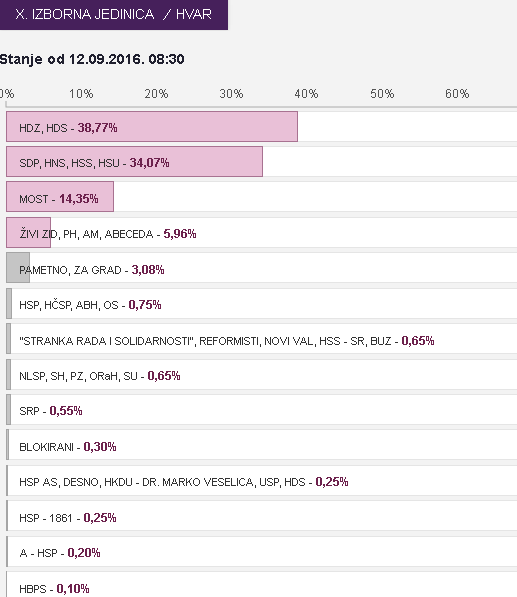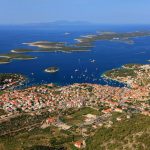How will the Croatian elections go? With things very tight, an interesting analysis – and method – from Vuk Vukovic from Oraclum Intelligence Systems on September 8, 2016.
A new prediction method for the Croatian elections
By Vuk Vuković
As the election date approaches, the uncertainty regarding its outcome is ever so high. And, so are concerns about the precision of the polls. The forecasts are, once again, suggesting a very close result, and are once again facing criticism for their lack of accuracy, complacency, herding, or even deliberate manipulation of results. Croatia is hardly the only country where pollsters are swiftly losing their reputation. It’s happening across the West, particularly in the UK and the US. With the rise of online polls, proper sampling can be extremely difficult. Online polls are based on self-selection of the respondents, making them non-random and hence biased towards a particular voter group (the young, the better educated, the urban population, etc.). On the other hand, the potential sample for traditional telephone (live interview) polls is in sharp decline, making them less and less reliable. Telephone interviews are usually done during the day biasing the results towards stay-at-home moms, retirees, and the unemployed, while most people, for some reason, do not respond to mobile phone surveys as eagerly as they once did to landline surveys. With all this uncertainty it is hard to gauge which poll(ster) should we trust and to judge the quality of different prediction methods.
However, what if the answer to ‘what is the best prediction method’ lies in asking people not only who they will vote for, but also who they think will win? This is exactly what our new prediction poll tries to do. We exploit the idea that each individual has some idea about how others will vote.
The BASON (Bayesian Adjusted Social Network) survey is an experimental polling method with an aim to give a precise prediction of elections. It primarily rests upon our Facebook survey, where we use a variety of Bayesian updating methodologies to filter out internal biases in order to offer the most precise prediction. In essence we ask our participants to express their preference of who they will vote for, and more importantly, how much do they think their preferred choice will get (in percentages). Depending on how well they estimate the prediction possibilities of their preferred choices we will formulate their predictive power and give higher weight to the better predictors.
The role of Oraclum
What is our stake at these elections? We are, above all, a non-partisan venture in its start-up R&D phase, interested in experimental testing of our models on real-life electoral data. We use social networks (Facebook and Twitter) to poll potential voters, after which we use our unique set of Bayesian forecasting methods to pick out the best and most precise prediction method. After having tested the survey at the Brexit referendum, and then again at the Croatian elections, we will apply the same methods on the forthcoming US Presidential elections in November 2016.
In our Facebook survey we will not use any user data from Facebook directly or indirectly, only the data the users provide us in the survey itself. We will have no knowledge of voter preferences of any individual user, nor will we be able to find that out.
The Facebook survey was kick-started one week prior to the elections, and will run up until Friday, 09th September 2016, when we aim to provide our final forecast (access it here: https://sabor2016.oraclum.co.uk/). Our forecasts will show both the total predicted seat allocation in parliament and for each district, as well as the probability distributions for all options in terms of seats taken. They will also show the distribution of preferences for the friends of each user (so that the user could see how his or her social network is behaving and who they, as a group, are voting for), as well as the aggregate predictions the survey respondents will be giving.
The results
The preliminary results are the following: the People’s Coalition (led by SDP) is in the lead with 60 seats, HDZ has 54, MOST has 13, Živi zid (Human blockage) has a potential of 7 seats, IDS 3, HDSSB 2, Milan Bandić1 to 2, and Pametno 1. Taking into account the marginal seats across all electoral districts, the situation is similar where Živi zid would lose two seats, which could benefit a number of parties, depending on electoral district.

After the first two days of the BASON survey the general conclusion is that the result will be similar to the one from last year’s elections, with two important differences: the SDP-led coalition will get the largest number of seats (although still about 16 seats short of a majority), and last year’s big surprise MOST will not be the only kingmaker party – they will be joined by the anti-establishment Živi zid. This result suggests another long round of negotiations to form a government. Furthermore, it is interesting to note the divergence of MOST’s political capital compared to the last election where they received a whopping 19 seats. We are again likely to get around 20 seats from voters positioning themselves against SDP and HDZ (not counting the regional parties), but this time in slightly different ratios. Živi zid will, according to our results, manage to take about 5 to 7 seats from MOST which came out bruised from their short-lived governing coalition with HDZ. However, a clear-cut conclusion as to who took the votes from whom is beyond the scope of our method.

Looking at electoral districts the biggest difference from last year’s election is SDP’s takeover of the 2nd electoral district from HDZ, most likely as a consequence of HSS switching sides and joining the People’s coalition at these elections. The People’s coalition is now expected to win in 6 electoral districts (1st, 2nd, 3rd, 6th, 7th, and 8th ) while the HDZ will win in the remaining 4 (4th, 5th, 9th, 10th). Victories achieved in the three battleground districts (2nd, 6th, 7th) is what makes the important difference and what will give the SDP-led coalition a slight edge.
According to the analysis of marginal seats (seats that can go to two or more parties at a given district), SDP has a potential to win one seat in the 2nd, 3rd, and 5th, but also to lose one in the 4th or 9th district. HDZ can gain a seat in the 2nd, 8th or 10th district, but also lose one in the 1st, 5th and 9th district. Živi zid and MOST both have potential gains and losses across the districts, either at the expense of the two big parties or at the expense of each other. MOST can therefore lose a seat in the 6th, 7th and 8th district, but also gain a seat in the 1st and 9th district. Živi zid can lose a seat in the first three and the 5th district and can only gain one seat in the 4th or 9th district. The coalition around Milan Bandić has a marginal seat in the 2nd district which it could easily lose to SDP, but it can also gain a seat in the 6th and 7th district, while the new party Pametno has a seat in the 10th district which it can lose, but it can also gain a seat in the 1st district, at the expense of MOST.
It should be noted that this is not our final prediction for the current elections. Each day, ending on Friday, the survey will be updated as the size of our sample grows. It is thus possible that the number of seats, particularly the marginal ones, varies as the final trends change right before election day.
To take part in the survey, click here.
To learn more about Vuk Vukovic, visit his official website.








